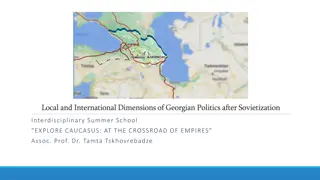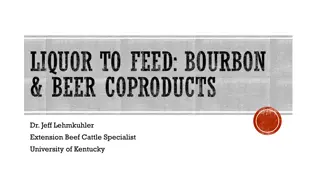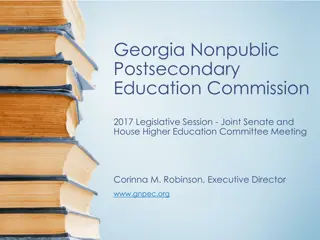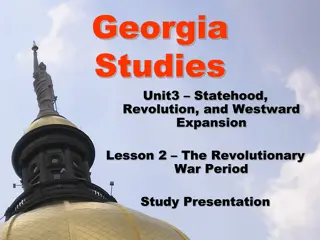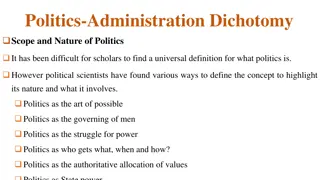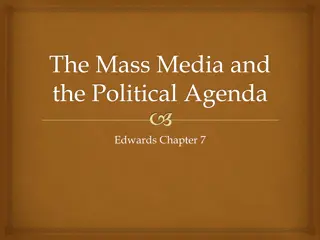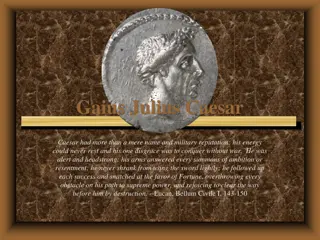The New South and The Bourbon Triumvirate in Georgia Politics
The New South movement aimed to diversify agriculture and expand industries beyond cotton production in a post-Civil War era. The Bourbon Triumvirate, comprising Joseph E. Brown, Alfred H. Colquitt, and John B. Gordon, exerted political influence in Georgia, promoting industrial development and white supremacy. They faced opposition from the Populist Party and New Democrats as their power waned towards the end of the 19th century.
Download Presentation

Please find below an Image/Link to download the presentation.
The content on the website is provided AS IS for your information and personal use only. It may not be sold, licensed, or shared on other websites without obtaining consent from the author. Download presentation by click this link. If you encounter any issues during the download, it is possible that the publisher has removed the file from their server.
E N D
Presentation Transcript
The New South Review
What was the name of the movement that sought to expand industries, to diversify agriculture beyond cash crops such as cotton, and grow more food crops? a. The Lost Cause b. The New South c. The Old South d. The Lintheads
The New South The rise of a south after the civil war which would no longer be dependent on now-outlawed slave labor or predominantly upon the raising of cotton, but rather a south which was also industrialized and part of a modern national economy However, the Democrats were still in control which meant that the idea of white supremacy and legalized segregation became the norm.
The Bourbon Triumvirate was a group made up of all of the following men except: a. John B Gordon b. Joseph Brown c. Alfred Colquitt d. Henry W Grady
The Bourbon Triumvirate believed in a. Stronger industrial ties with the North b.White supremacy c. Improving Georgia s economy d.All of the above
The Bourbon Triumvirate The Bourbon Triumvirate was a group of three politicians (Joseph E. Brown, Alfred H. Colquitt, and John B. Gordon) who dominated Georgia politics for over 20 years. These men, who all had been key figures during the Civil War, rotated positions as governor and U.S. Senator from the 1870s to 1890s. They held a common interest in developing the railroad and mining industries in Georgia, serving the interest of those men who were part of the old antebellum planter class, and instituting low taxes which resulted in few government services. In addition, all three of the men were white supremacists who supported and took advantage of the convict lease system. The power of the Bourbon Triumvirate began to decrease as the ideals of the Populist Party and the New Democrats began to dominate the Democratic Party in 1890, as well as, the deaths or retirement of the three members.
Earned the rank of major general during the Civil War due to his fearless fighting. Believed to have been a leader of the Georgia chapter of the KKK. Member of the Bourbon Triumvirate. Was elected U.S. Senator between 1872 and 1880, Governor in 1886, and back as a U.S. Senator between 1891- 1897. The above notes describe a. John B Gordon b. Joseph E Brown c. Alfred H Colquitt d. Henry Grady
Started off as a U.S. Representative but returned to Georgia and was elected to the Georgia General Assembly in 1859. Was elected to the Georgia Secession Convention in 1861 and joined the Confederate Army after Georgia seceded during the Civil War. Was elected as Georgia s governor from 1876-1882 and U.S. Senator from 1883-1894. Was a member of the Bourbon Triumvirate The above notes describe a. John B Gordon b. Joseph E Brown c. Alfred H Colquitt d. Henry Grady
Promoted the New South industrialization by writing editorials and articles in the Atlanta Constitution newspaper Managing Editor of the New South Was known as the Voice of the New South Traveled to New York to give speeches to attract northern investment but was criticized for inaccurately portraying the racial problems in the South. Promoted the International Cotton Expositions to bring investments to Atlanta The notes above describe a. Rebecca Latimer Felton b. Henry W. Grady c. Alonzo Herndon d. Tom Watson
Elected governor of Georgia in 1857 and was governor throughout the Civil War. Became a Republican for a short period of time. He was the chief justice of Georgia s Supreme Court during this time. After a brief switch to the Republican party, he switched back to the Democratic party and was elected to the U.S. Senate from 1880-1890. Member of the Bourbon Triumvirate. The above notes describe a. John B Gordon b. Joseph E Brown c. Alfred H Colquitt d. Henry Grady
Henry Grady Is best known for his continual promotion of the New South. As managing editor of the Atlanta Journal, Grady was able to use the newspaper as a stage to promote his views concerning the industrialization of the South, the diversification of southern agriculture, and to lobby northern investors to help aid financially in both causes. Grady is given credit for being instrumental in bringing the International Cotton Expositions to Atlanta and for the creation of the Georgia Institute of Technology (Georgia Tech). He was also active in local politics assisting in the elections of liked minded politicians such as John B. Gordon and Joseph E. Brown.
Henry Grady Grady also had his critics. He was often attacked by Populist Tom Watson and Georgia s farmers for his industrial focus. Elected officials of Georgia s other cities such Athens, Augusta, and Macon, criticized Grady for his blatant bias in favor of Atlanta. Many civil rights groups both in the North and South, were doubtful of his portrayal of racial relations in Georgia in order to bring in northern investment.
Henry Grady He lived to the age of 39. Due to his achievements, Grady has been honored in several ways throughout the state including having a county named for him. Grady Hospital and the University of Georgia s Grady School of Journalism are also named in his honor.
During the New South Era, why did Georgia host three "expositions" between 1881 and 1895, such as the International Cotton Exposition? a. to encourage tourism b. to attract industries, investments, and jobs c. to increase political power d. to oppose the New South concept
International Cotton Exposition In 1881, 1885, and 1895, Atlanta was the site of three International Cotton Expositions. Primarily, the Cotton Expositions were established to promote Atlanta s rebuilding from the Civil War, its industrial capabilities and accomplishments, and to lure northern investment into the city and region. The first two were heavily promoted by Henry Grady, but the most memorable was the exposition held in 1895.
International Cotton Exposition During the exposition of 1895, also known as the Cotton States and International Exposition, civil rights activist and educator, Booker T. Washington, gave his famous Atlanta Compromise Speech. This speech urged African-Americans to focus on economic improvement as opposed to political and social rights, an idea that was supported by white New South advocates, but not accepted by African-American leaders such as W.E.B. Dubois.
Disagreed with the Bourbon Triumvirate s New South movement Passed the Rural Free Delivery of mail bill The leader of the Populists Party that supported the small rural farmers The notes above help describe the role and impact of a. W.E.B. DuBois b. Henry Grady c. Booker T. Washington d. Tom Watson
Tom Watson Tom Watson was one of the most popular and most controversial figures in Georgia history. His early law and political career was based on supporting the poor tenant farmer and share cropper of both races. When he was elected to the Georgia General Assembly in 1882, he supported the end to the convict lease system and was a proponent of public education for all Georgians. However, due to his discontent with the policies of the New South advocates in the General Assembly, Watson resigned before the end of his term.
Tom Watson Started off a Democrat but changed to the Farmers Alliance, which eventually became the Populist Party worked for the poor farmers. Watson played an important role in the passage of the Rural Free Delivery Act. Mail was delivered to rural areas which previously were not served. Was Populist Parties Vice President and Presidential candidate.
Tom Watson Watson began to change his views toward race and by the end of his life he was a white supremacist. He not only targeted African-Americans but Catholics and Jews as well. He used his newspaper and magazine, The Jeffersonian, to promote his political, social, and economic viewpoints According to some, his series of articles against Leo Frank led to his lynching.
Worked to abolish the convict lease system. Fought to help women earn the right to vote which is known as Women s Suffarage and was against the use of alcohol which is known as prohibition. Became the first woman U.S. Senator after being appointed to take the position upon the death of Tom Watson. Since Congress was not in session, she was not sworn in and only served for 1 day. The notes above describe a. Lugenia Burns Hope b. Rebecca Latimer Felton c. Nancy Hart d. Alitia Hall Colquitt
Rebecca Latimer Felton After the Civil War, Felton s primary focus was the political career of her husband who served three terms in the U.S. Congress and three terms in the Georgia General Assembly. As members of the Independent Democrats, the Felton s spent years battling with the members of the Bourbon Triumvirate especially John B. Gordon, over their often self-serving policies. Felton supported many progressive causes, including abolishing the convicted lease system, prohibition, and, most importantly, Women s Suffrage. In 1899, she began writing a column for the Atlanta Journal. Upon the death of Tom Watson, Georgia governor Thomas Hardwick appointed her as a temporary U.S. Senator in honor of her work and achievements in the state.
Citizens in Atlanta witnessed an angry mob of white men killing over 20 black men and wounding hundreds of others. This event in Georgia s history is known as a. the New South movement. b. the Leo Frank case. c. the 1906 Atlanta Race Riot d. the Atlanta Compromise
What was the immediate cause of the Atlanta Race Riot of 1906? a. Increased activity of the Ku Klux Klan b. Disenfranchisement c. Alleged attacks on white women in newspapers d. An increase in lynchings
1906 Atlanta Race Riot The immediate spark for this 48-hour riot (September 22-24) was a series of local newspaper articles alleging African-American male attacks on white women. These articles proved to be untrue. However, as with most historical events, there were many other deep-seated causes of the riot. These included the large number of unemployed and frustrated whites who viewed African-American as threats to jobs and the established social order. Additionally, Georgia gubernatorial candidates Hoke Smith and Clarke Howell fueled the racial fires as they based their campaigns on the platform of white supremacy.
1906 Atlanta Race Riot On the morning of the riot, there were four articles published about assaults on white women. A group of mostly unemployed white men and boys gathered in downtown seeking revenge for the false attacks. Though city officials tried to calm the mob, the group of men began attacking any black that they saw. Travelling into the black business, district the mob killed two barbers and beat several men to death on street cars. Due to the violence, the Georgia militia was called in to the city. In turn, African-Americans began to arm themselves and in some cases fought off their attackers. Despite these efforts, sporadic fighting occurred throughout the next day.
Leo Frank a. was a governor who reduced a man s death sentence to life in prison b. began a school in Rome for under- privileged children c. was a pencil factory manager who was tried and convicted of the death of a 14-year-old worker d. druggist who created Coca Cola as a medicine
What happened to Leo Frank after his trial? a. he was sentenced and put to death b. he spent the rest of his life in prison c. he was taken from jail and lynched d. he was found guilty, but was later freed
The trial and conviction of Leo Frank for the murder of Mary Phagan shows a. The fairness of the southern judicial system b. Georgia s resistance to Reconstruction c. Georgia s support for governor Hoke Smith d. Racial unrest and anti-Jewish feelings prevailed in Georgia in the early 1900s.
Leo Frank On April 26, 1913, Mary Phagan went to the pencil factory to collect her $1.20 pay check for a 12 hour work week. Phagan received her pay from her supervisor, Leo Frank, and then left. She never returned home and, later that evening, her beaten body was found in the basement of the factory. Frank was convicted of killing Phagan and was sentenced to death.
Leo Frank Due to their fear that Frank would eventually be released, community members of Marietta, Mary Phagan s hometown, drove to Milledgeville where Frank was being held. They managed to walk into a state prison, remove Frank, and drive him back up to Marietta. Calling themselves the Knights of Mary Phagan they lynched him. Later, residents posed for photographs next to his body and these photos, in the form of postcards, were sold as souvenirs. In 1986, primarily due to the testimony of Alonzo Mann, the Georgia State Board of Pardons finally pardoned Leo Frank. Mann claimed that as a boy, he saw John Conley carrying Phagan s body and, when discovered, Conley threatened to kill him if he said anything
During the 19thand early 20th century _________ laws segregated public facilities in the South. a. Black codes b. Desegregation c. Jim Crow d. White primary
All of the following were reasons for passing Jim Crow" laws in Georgia EXCEPT a. to encourage industrial growth b. to enforce the policy of segregation c. to preserve white control d. to disenfranchise African Americans
A law which forbids a white person and a black person from using the same public facilities would be considered a. A grandfather clause b. Disenfranchisement c. A black code d. A Jim Crow law
Homer Plessy sat in Whites Only car on a train because he wanted a. The only seat available b. The comfortable seats there c. To sit with his traveling companions d. To test the legality of a law requiring separate-but-equal facilities
In response to the passage of Jim Crow laws, African Americans took their complaints to the courts. The Supreme Court ruled what in the Plessy v. Ferguson case? a. separate but equal facilities were unconstitutional b. separate but equal facilities were lawful c. separate but equal applied only to rail cars for African Americans and whites in their travels across the country d. separate but equal was a problem that needed immediate attention
Plessy v. Ferguson gave states the right to promote a. equal rights b.terrorism c. segregation d.voting rights for blacks
What is the correct definition of the term disenfranchisement ? a. A literacy test that determined if people could read and understand the Constitution. b. A tax that had to be paid before a person could vote. c. A way of depriving a person of one of the rights of citizenship, especially the right to vote. d. A rule that said a person could only vote if his or her grandparents had voted.
The poll tax was used a. To help raise money for new schools. b. To make sure only state residents would vote. c. To keep African Americans from voting. d. All of the above
The grandfather clause allowed a. Grandfathers to vote without paying a poll tax. b. Anyone to vote who had a grandfather born in Georgia. c. Grandfathers to vote without taking the literacy test. d. Anyone to vote if a grandfather had been able to vote before the Civil War.
___________ was one of the strategies used in the South to keep African-Americans from exercising their political rights by preventing them from running in the primary elections. a. Poll tax b. Grandfather Clause c. Literacy test d. White primaries
Which voting qualification was designed to prevent African- Americans from voting by requiring them to demonstrate their ability to read and write as well as their knowledge? a. party affiliation b. identification numbers c. literacy tests d. residency requirements
Which form of disenfranchisement allowed less populated counties in Georgia to have the same or greater political power as more populated counties through allotting votes? a. Poll Tax b. Literacy Test c. Grandfather Clause d. County Unit System
Why did Georgias political leaders adopt such policies such as the poll tax and white primary? a. To create a county unit system b. To segregate Georgia s schools c. To stop blacks from voting d. To allow women to vote
Founded and was president of the Tuskegee Institute Promoted the idea that the best approach for African- Americans to gain power and civil rights is through hard work, education, and economic accomplishments. Gave speech at the Cotton States and International Exposition that became known as the Atlanta Compromise. In his speech he suggested that progress could not be forced and would come gradually. The notes above describe Booker T Washington John Hope Alonzo Herndon WEB DuBois
Booker T Washington Was born a slave He was the founder of Tuskegee Institute. Publically Washington promoted the idea that the best approach for African-Americans to gain a foothold in white society was through hard work, education, and economic accomplishments, before gaining full civil rights. Was criticized by individuals and groups such as W.E.B. Dubois and the NAACP for these ideals Washington secretly provided financial support for many civil rights cases actively testing voting and other rights for blacks.
Booker T Washington Along with his contributions to education and civil rights, Washington was the first African- American to be invited to a formal dinner at the White House. In Georgia history he is most well known for his Atlanta Compromise Speech which he presented at the International Cotton Exposition of 1895. This speech brought his ideas of cooperation and the going slow approach to the forefront of the early civil rights movement.
Atlanta University Professor Promoted the education of the Talented Tenth of African Americans to become leaders of all other African Americans. Believed in immediate social and political rights of African-Americans. Helped form the National Association for the Advancement of Colored People (NAACP). The notes above describe a. Booker T Washington b. John Hope c. Alonzo Herndon d. WEB DuBois
W.E.B DuBois Often viewed as Booker T. Washington s intellectual opposition Supported many of Washington s beliefs early in his career. However, after the actions of the southern states to prevent African-American civil rights along with events such as the Atlanta Race Riot, DuBois was determined to fight for immediate social and political rights of African-Americans. Dubois developed the concept of the talented tenth or an elite group of college educated African- Americans who would use their talents and position to help eradicate segregation in American society.
W.E.B DuBois DuBois accepted a position at Atlanta University (later Clark Atlanta). DuBois became an important figure in the early Civil Rights Movement. His organization, the NAACP, and his ideals for immediate social and political rights for all African- Americans, led to the successes of the Modern Civil Rights Movement of the 1950s and 1960s.








